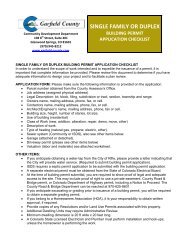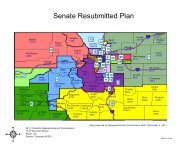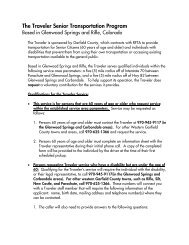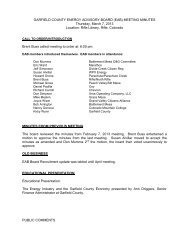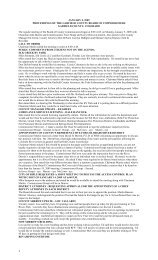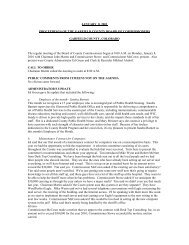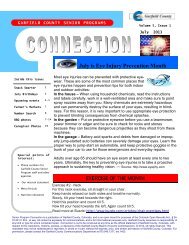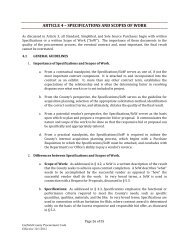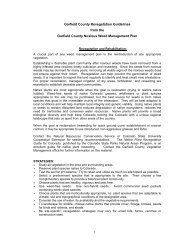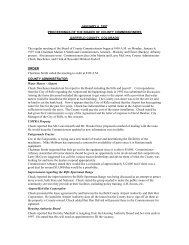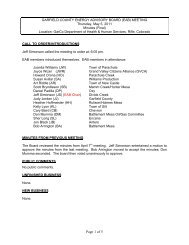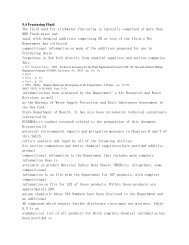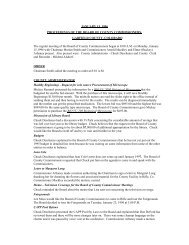Appendix D: Human Health Risk Assessment - Garfield County ...
Appendix D: Human Health Risk Assessment - Garfield County ...
Appendix D: Human Health Risk Assessment - Garfield County ...
You also want an ePaper? Increase the reach of your titles
YUMPU automatically turns print PDFs into web optimized ePapers that Google loves.
<strong>Appendix</strong> D Screening Level <strong>Human</strong> <strong>Health</strong> <strong>Risk</strong> <strong>Assessment</strong> February 2011<br />
Battlement Mesa, Colorado <strong>Health</strong> Impact <strong>Assessment</strong> Colorado School of Public <strong>Health</strong><br />
• Some residents live within ½ mile of more than one well pad and are exposed to<br />
emissions from well completion activities for at least 20 months.<br />
• A resident, including elderly adult, lives, works, and otherwise stays at the home<br />
for 24 hours per day for 20 months.<br />
• The air the resident adult breathes, both while indoors and outdoors, contains the<br />
same concentration of contaminants measured during odor events in the 2005-<br />
2007 ambient air study.<br />
• The concentration of contaminants in ambient air will stay constant over the 20month<br />
period.<br />
Table 3-2 summarizes intake rates for ambient air. The intake equation for the<br />
intermediate exposure scenario follows.<br />
AI = (EPCs x EFs x EDs x ET x 1 day/24 hours)/AT<br />
AI = Air Intake (µg/m 3 )<br />
EPCs = Subchronic exposure point concentration (µg/m 3 )<br />
EFs = Subchronic exposure frequency = 350 days/year<br />
EDs = Subchronic exposure duration = 20 months (1.66 years)<br />
ET = Exposure time = 24 hours/day<br />
Non-cancer AT = averaging time = 583 days<br />
3.5.4 Child Resident Living Near Well Pad Acute Exposure<br />
Assumptions and Intake Equations<br />
Only ambient air and surface water pathways were quantitatively evaluated for the child<br />
acute exposure scenario because data on which to estimate surface soil EPCs is not<br />
available. The acute exposure area for contaminants in ambient air is homes and yards<br />
located near a well pad. The acute exposure areas for contaminants in surface water are<br />
puddles in the yards of homes adjacent to well pads resulting from well pad run-off<br />
during precipitation events. A child resident was evaluated as the receptor for this<br />
exposure scenario because a child is more likely to play in a puddle and is a more<br />
sensitive receptor than an adult.<br />
The acute EPCs for ambient air were the 95% UCL and the maximum detected<br />
concentration observed in grab samples collected during odor events in CPDHE’s 2005-<br />
2007 ambient air study and grab samples collected by Antero during well completion<br />
activities in August 2010. The EPC for a puddle of surface water run-off was estimated<br />
from contaminants observed in snow-melt run-off collected from a well pad within the<br />
three-mile radius of the former Project Rulison near Rulison, Colorado (URS 2008), as<br />
presented in Table 3-3.<br />
The following assumptions for acute exposure of a child resident to contaminants in<br />
surface water puddles are used in this HHRA based on EPA methodology.<br />
<strong>Appendix</strong> D page 27



